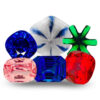Origin Opinions - When Gem Labs Agree To Disagree

Homo Sapiens are obsessed with origins. When we meet people for the first time, we want to know where they come from. We want to know where the universe came from, we want to know where life came from, and we want to know where our cars come from as we perceive certain origins such as Italy and Germany to be sources of the finest luxurious automobiles money can buy. So, it should come as no surprise that we want to know where our gemstones come from, especially since we become so intimate with the beautiful, rare and valuable things we adorn our bodies with.
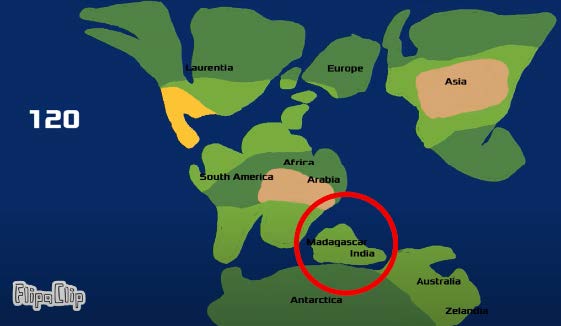

Earth’s geology has a highly mobile history. 200 Million years ago, Greenland was a tropical paradise, and 120 million years ago Madagascar, Sri Lanka and India were the same place (Figure 01). When they separated, the part that moved northeast became the Indian subcontinent with the island of Sri Lanka trailing along, and Madagascar moved northwest following the new continent of Africa (Figure 02). With this knowledge, we can begin to understand how, and why well respected gemological laboratories disagree on gemstone origins, from time to time.
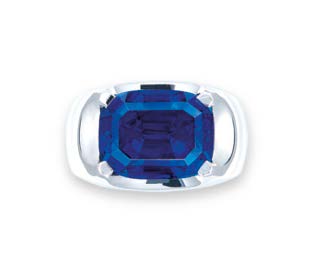
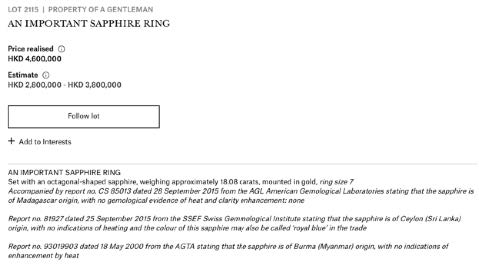
Of the big three, rubies, sapphires and emeralds, sapphires present the greatest challenge to gem labs in correctly determining origin. Nowhere is this more obvious than with the occasional Christie’s or Sotheby’s auction offerings presenting multiple origin opinions from highly respected gem labs. Probably the most notorious example would be an 18.08 carat unheated natural sapphire offered at Christie’s Hong Kong Magnificent Jewels auction on December 1st, 2015. AGL lab determined Madagascar, SSEF said Ceylon (Sri Lanka) and the AGTA lab stated Burma as their origin opinion. In spite of this discrepancy, this extra fine sapphire fetched approximately 20% more than the pre-auction high estimate (Figures 03 & 04).
The Advent of Origin Reports
Dr. Edward Gubelin issued the very first gem lab origin report on March 18, 1940 for a brilliant cut blue sapphire of 1.53-carats from Burma (Figure 05). American Gemological Laboratories (AGL) became the first gemological laboratory in the US to provide country-of origin determinations for colored stones, and their reports are regularly featured by Christie’s and Sotheby’s. As demand increased, eventually all other major labs followed suit and began offering ruby, sapphire and emerald origin reports.
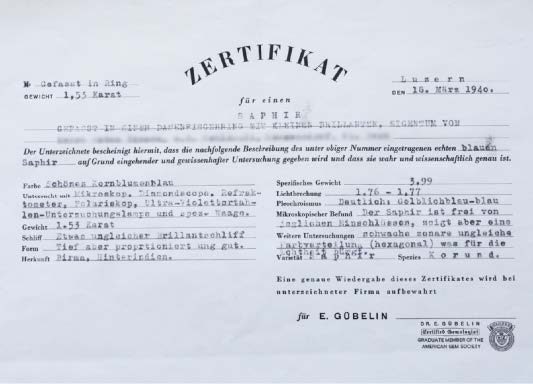
Inclusions and Trace Elements
So, let’s delve into the scientific gemological reasons of exactly why certain sapphires can be so challenging to accurately determine origin. Predominantly, there are only two characteristics of gemstones examined and compared by gemological laboratories which give clues, or in some cases relative certainty as to origin; Inclusions, and Trace Elements.
Inclusions are comprised of foreign mineral crystals, metals, liquids, gases, negative crystals, feathers, fingerprints, clouds, fractures, partially healed fractures, and combinations known as multi-phase inclusions which can be solids in a liquid, gas in a liquid, or all three, know as three-phase inclusions common to emeralds from several different origins.
Trace elements occur in very small percentages and include color inducing elements known as chromophores such as Fe, Ti, Cr, V, Cu, Mn, Be (bulk diffusion) and a wide variety of non-color inducing elements such as Ca, Ga, Ge, Hf, K, La, Mg, Nb, Ni, Sn, Ta, Th, U, W, Zn, Zr.
Reliable Specimens and Comprehensive Databases
So, in order to interpret data generated by studying inclusions and trace elements, you need a comprehensive database from which you can compare your gemstone in question to a wide range of specimens of known origin. The pre-requisite is, of course, collecting an extensive selection of specimens reliably known to have come from the various sources. Renowned field gemologist Vincent Pardieu explains his hierarchy of gemstone origin specimen acquisition writing “with each sample I collect, I attach a code documenting how the sample was collected” (Figure 18):
“A type” sample means that the field gemologist mined it;
“B type” means that the field gemologist witnessed the mining of that sample;
“C type” means that the field gemologist collected the sample on site, at the mine but without witnessing the sample being mined. For example, it could have been in a miner’s pocket…;
“D type” sample was collected from the miner but not at the mine;
“E type” sample was not collected from the miner, but it was collected in the region where it was mined from a merchant or anybody besides the miner (so in that regard, any faceted stones, as it was cut by a cutter, cannot be of higher rank than “E type”);
“F type” sample was collected from a secondary source in an international market, like an International Gem Show;
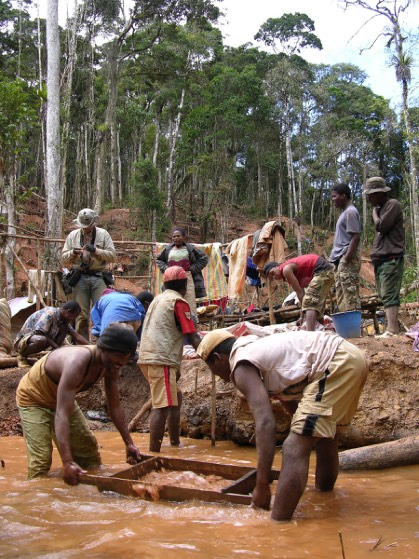
With an extensive selection of origin reference samples in hand, using a wide variety of traditional and modern hi-tech gemological diagnostic equipment, gemological laboratories carefully analyze inclusions and trace elements to build their databases for comparing their
many varying, and often overlapping characteristics.
SIDEBAR: From the Loupe, to Alphabet Soup
Gemmology has come a long, long way from the time when magnification was the most useful diagnostic tool available. Today, we have an impressive selection of high-tech equipment at our disposal which in some cases has been specially adapted to gemology. Technologies include:
UV-Vis Spectroscopy
Raman Spectroscopy
Confocal-Raman Microprobe Spectroscopy,
Photoluminescence Spectroscopy
X-ray fluorescence spectrometry (XRF)
Fourier Transform Infrared Spectroscopy (FTIR)
Laser Induced Breakdown Spectroscopy (LIBS)
Energy Dispersive X-ray Fluorescence (EDX-RF)
Laser Ablation–Inductively Coupled Plasma–Mass Spectrometry (LA-ICP-MS)
Laser Ablation Time-of-Flight Mass Spectroscopy (LA-TOF-MS)
X-ray Microtomography (XRM)
Scanning Electron Microscopy (SEM)
The Swiss Gemmological Institute SSEF Education Department located in Basel, Switzerland is one of the only institutions worldwide to offer scientific gemmology and scientific diamond courses where participants can learn about FTIR spectrometry, UV-VIS spectrometry, Raman microspectrometry, X-ray fluorescence spectrometry (XRF), and other approaches to scientifically testing gemstones. Advanced gemmological education is a requirement, and each participant of this international course receives the SSEF Scientific Gemmology Certificate – SGC . Some of SSEF’s in-house gemmologists even use the SGC title when signing SSEF Testing and Gemstone Reports along side gemmologists with GG, FGA and DUG gemmological credentials.
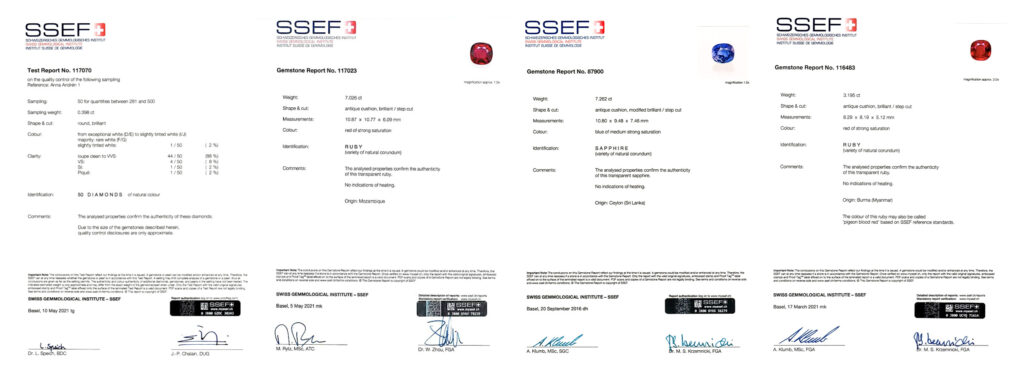
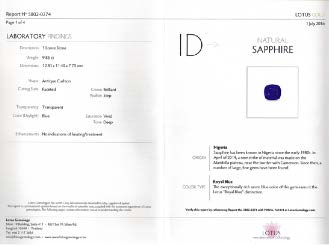
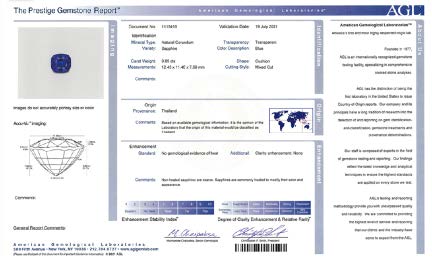
Madagascar Mimicking Kashmir
The gem trade received a rather disturbing shock when in 2017, SSEF published a TRADE ALERT regarding confusion between a new deposit of gem grade sapphires in Madagascar which exhibited distinctly similar characteristics to those for the famed mines if Kashmir, India (Figure 06).
SSEF wrote: “This trade alert focuses on those sapphires from this new source in Madagascar which have a ‘Kashmir-like’ visual appearance. They are characterized by a subtle and fine milkiness, which results in a velvety blue colour as is known from top-quality Kashmir sapphires. Unfortunately, many of these new sapphires are accompanied by gemmological reports describing them as being of Kashmir origin. Having recently tested an important number of such ‘Kashmir-like’ sapphires submitted by clients and ranging in weight from 5 to 50 ct, we have to conclude that many of these gems of so-called Kashmir origin actually originated from the new deposit near Bemainty/Ambatondrazaka in Madagascar”.

The problem for sapphire buyers is the radical market price differential between Kashmir sapphires and sapphires of all other origins. The auction record for a Ceylon (Sri Lanka) sapphire is $50,900 per carat, for a Burma sapphire it is $59,600 per carat, and for a Kashmir, three to nearly five times times higher at $243,703 per carat . As SSEF noted, many of these Madagascar sapphires are accompanied by gemmological reports describing them as being of Kashmir origin. Gemstone dealers aware of this discrepancy often demand at least three reports from internationally respected gemological laboratories before laying their money down for a Kashmir sapphire at a Kashmir price.

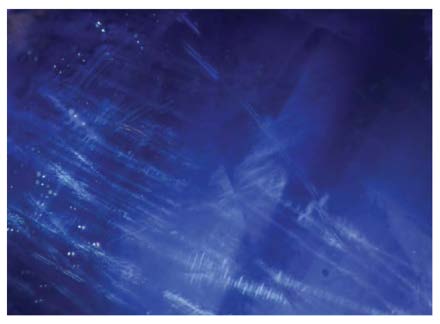
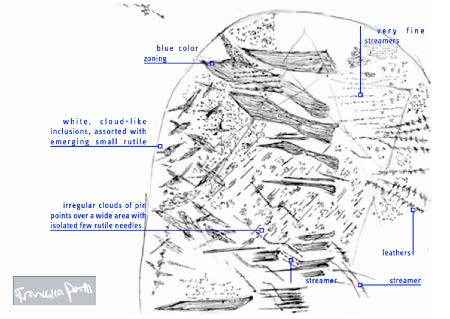

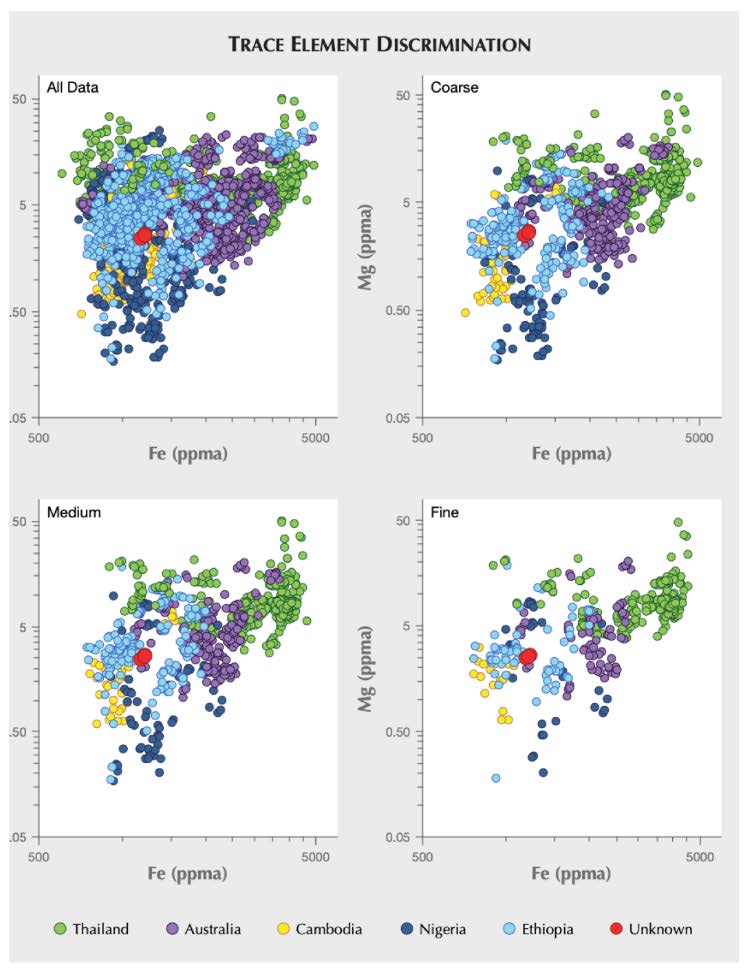
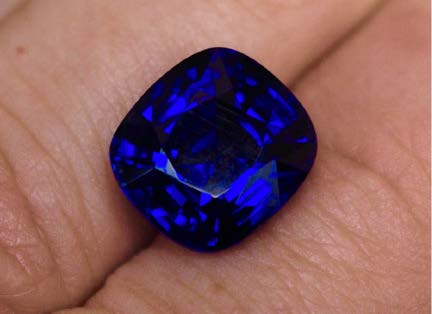

Metamorphic, Basaltic, and Basaltic-Like
A sapphire origin opinion of Vietnam or Madagascar means it could be either from a metamorphic, or a basaltic-type deposit. Further exacerbating the confusion is when certain sapphires from known metamorphic deposits exhibit basaltic-like characteristics. The best example of this is the Baw Mar sapphire mine in Mogok, Burma, owned and managed by Ye Minn Htoon, affectionately know as Ko Choo (Figure 15).
GIA writes on the subject “Blue sapphires collected from the Baw Mar mine in Mogok showed properties distinctly different from those associated with “classic” Mogok blue sapphires. The Baw Mar samples, which are formed in syenite which intruded into weathered gneiss, as well as from pockets formed at the exposed leucogranite, typically exhibit greenish to violetish blue colors. They are often free of inclusions, sometimes with twinning in multiple directions and needles (most likely boehmite) at the intersections of the twin planes. They also exhibit small platelets, healed and open fissures, irregular needles that are most likely ilmenite and, rarely, short needles that are probably rutile. The few crystal inclusions were identified as K-feldspar and mica by micro- Raman analysis. Their UV-Vis-NIR spectra are different from the inclusions of classic Mogok blue sapphires, with high iron-related bands; as a result, they are sometimes confused with basaltic blue sapphires.
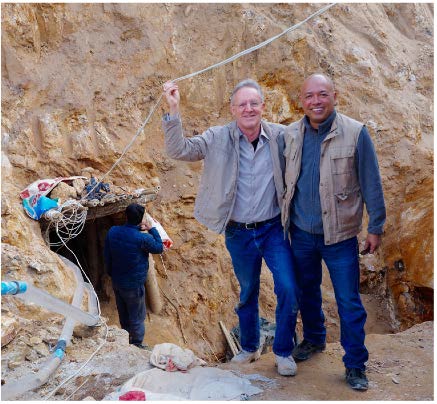
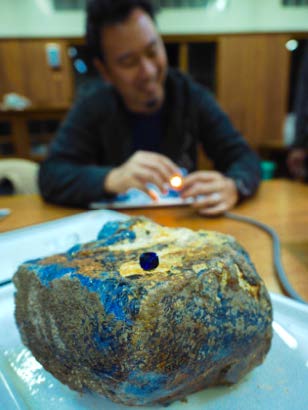
Chemical analysis also shows relatively high iron, low gallium, very low titanium contents, and Ga/Mg ratios that strongly vary from sample to sample. The presence of boehmite and mica bands is confirmed by FTIR. Additional research is underway on the Baw Mar sapphire geological formation, as well as on classic Burmese blue sapphires and similar-looking material from other mines worldwide. This research will shed further light on the positive identification of samples from this mine, as well as increase understanding” (Figure 16).
ICA Gem Lab Director Ken Scarratt weighing in on the subject writes:
“For someone who has spent the better part of the last fifty years assisting the gemstone and pearl trade, from an arms-length perspective, I find origin determination, and its chronicled history simply fascinating. For me personally the fascination has been indelibly linked to an ever deeper-learning about the gems we love to handle and treasure. For others it has been simply about providing a service that the trade today have come to expect and to earn a living.
Sapphires are divided into two types based on the geological conditions under which they were formed: Metamorphic and Basaltic. Classic metamorphic deposits are located in Kashmir, Burma, Sri Lanka, southern Madagascar, northern Vietnam and Tanzania. Typical basaltic deposits are found in Australia, Cambodia, China, Laos, Thailand, Nigeria, and several other locations around the world.
GIA writes of this subject “As with most geographic origin determinations, however, there will almost always be overlap, and in many cases the trace element chemistry evidence is ambiguous. For basalt-related blue sapphires, ambiguous trace element data typically lead to an “inconclusive” origin call because of the often indistinct nature of their inclusions” .
SSEF wrote concerning one unheated blue sapphire: “originates from a basalt-type deposit like in Kanchanaburi (Thailand), Pailin (Cambodia) Australia or Rwanda to name a few. The properties of the examined gemstone do not permit a sufficiently safe identification of geographical origin. A Sri Lankan, Burmese, or Kashmir origin can be excluded” .
When gem labs do feel confident in issuing an origin opinion on basaltic-type sapphires, they are, occasionally, not in agreement as with this 9.85-carat unheated sapphire which Lotus Gemology wrote Nigeria, and AGL said Thailand, (Figures 12,13) despite them being 10,000 kilometers apart. The problem arises for sellers and buyers since extra fine sapphires of Thai origin are in high demand by Thai consumers, and as such will sell much faster, and for a higher price than sapphires of Nigerian origin, despite their equal beauty and gemological similarities.
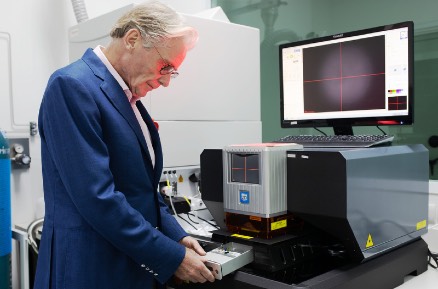

But let us begin at the point in history when the trade had a real difficulty in articulating what it truly wanted. In the 1980’s while attending a CIBJO Coloured Stone Commission Meeting in Basel the attendees again voted on a clause in the then “blue book” that basically “outlawed” the use of origins on gemmological Reports, not that they had any real authority to do so. What transpired simply days after that Congress was that some of the very same individuals who voted for the outlawing of origin determinations came down the stairs of our basement laboratory in London’s Hatton Garden district to ask the question “hi Ken, do you think this blue sapphire comes from Burma?”. “Please tell me because it makes a huge difference to the price”.
Of course in those days the only blue sapphires of interest were those emanating from Kashmir, Burma or Sri Lanka; but the inclusion scenes, particularly between the latter two could be not just similar but the same. Remember at the time that UV/visible spectroscopy was in its infancy and chemical analysis was limited to what could be gained from based electron microprobes only available in universities, so basically it was inclusion-based determinations predicated upon user experience. Not the safest approach to assigning a factor that may impact the monetary value of the sapphire. But it was the only approach possible at the time. I do note at the time, however, that pieces of art were often assigned to famous artists with no more than a magnifying-glass observation.
Times change and instrumentation has evolved significantly over the intervening decades, accurate trace element chemistry is now available with LA-ICP-MS in all those laboratories that have the required budgets to purchase and operate such sophistication, or at least have access to the instrumentation in one form or another, also UV/visible and FTIR spectroscopy are now standard test methods. Along with this, however, trade demands for origin determinations has “blossomed” to the extent that some demand this service not just for the usual culprits but for a wide range of other gems, e.g., alexandrite, which might be expected given the value, but also amethyst, peridot, and various garnets.
This all leaving the laboratories in the permanent state of “catch-up” where they remain today. One area where a “catch-up” was clearly, and obviously needed, at least to some of us, was in the acquisition of validated samples from all locations and the continued acquisition over time from the same as well as new locations. Put simply, a laboratory with all of the latest analytical technology at its fingertips, has nowhere to go if it does not have fully validated samples. By fully validated samples we mean samples collected at the mine site by a qualified field gemmologist who is tasked with recording the acquisition in detail and ensuring a clear chainof- custody back to the laboratory. Overall quite an expensive undertaking and with the limited human resources available in most labs resulting in each lab operating with data collected from samples that may indeed be validated but maybe collected at different timelines or from sites ‘only of current interest’ to that laboratory and certainly different to the collections of other laboratories.
So if we have arrived today at a situation where it is understood that validated samples and sophisticated analytical techniques (alongside normal gemmological observations) are prerequisites for gemstone origin determinations why are there still differences of opinions particularly with blue sapphire origins?
With emeralds there are a plethora of trace elements to use in population plots that create potentially wider separations in the final analyses with individual mines having a fairly stable trace element suites over time. This added to UV/visible and IR spectra along with inclusion observations, all makes for a more predictable origin call. With rubies a combination of the same factors but nevertheless with fewer trace elements available also produce more reliable origin determinations than for sapphire. This is not to say that sapphire origin determinations cannot be reasonably accurate, indeed some are, but the data overlap within each laboratory’s data sets, is significant between the most popular sources, Madagascar, Sri Lanka, Burma and Kashmir, and even more so between the commercial sources from Basaltic locations.
So assuming that certain gemmological laboratories have the budget to own and operate sophisticated analytical tools and have well trained analysts and experienced gemmologists to analyse the data and then to collect a certain number of validated samples, where are we failing the community in the analysis of blue sapphires? To me, this clearly lies in the failure of laboratories to “pool” validated samples and the data acquired from them. For if such pooling occurred the data sets would be much wider and more reliable, and therefore allowing for more consistent/accurate determinations.
There was a time in recent history, pre-1985, where real sharing between laboratories was common place, but this was of a time where cooperation towards accuracy and gemmological passion overruled what is today the present business led focus where life is all about being first, the I am better than you syndrome, collecting as many IP’s to store away as possible and having the greater number of FB, IG or LinkedIn followers. Basically, Islands of great knowledge with oceans of water and the vast expanse of space, between.”
As Gubelin GemLab writes of sapphire origin determination: “despite skillful assessment and evaluation of carefully collected analytical data, the determination of the origin is not feasible for every stone.” GIA weighing in on the subject says “The colored stone trade wants the laboratories to be able to tell them with 100% accuracy where their colored gemstones come from, and for these determinations to be consistent between all the major laboratories. Unfortunately, science cannot provide this capability. In fact, science by itself cannot even come close to this for certain gemstones—most notably blue sapphires .”
Age Dating
Gemstone deposits around the world formed at different times during geological history. Therefore, the age dating of gemstones is a promising new technique being researched and utilized by several prominent gemological laboratories.

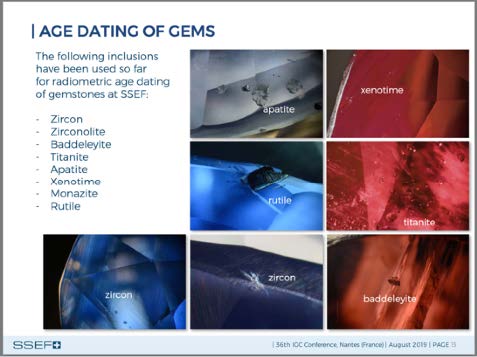
The John Saul mine in Kenya produces a small percentage of gem quality transparent rubies of exceptional quality with strong fluorescence reminiscent of rubies from Burma. The geological age of the John Saul deposit is approximately 600Ma, where at the formation of the rubies of Mogok took place 18-20Ma (Figure 21). So, if gemologists are able to determinate the approximate geological age of a ruby through various techniques, they can say with certainty it is not from John Saul in Kenya, or not from Mogok, Burma based strictly on geological age. It is also of particular use in separating Kashmir (-25Ma) from Sri Lanka or Madagascar sapphires (-560Ma) ( Figure 20).
So far, SSEF has identified the following inclusions for radiometric age dating of gemstones; Zircon, Zirconolite, Baddeleyite, Titanite, Apatite, Xenotime, Monazite and Rutile (Figure 19). The obvious constraint of this technology is if one of these types of inclusions suitable for age dating cannot be isolated and tested in a gem, then it is useless.
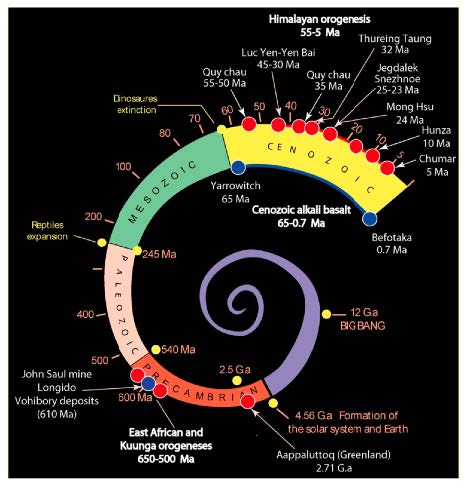

Building Gem Lab Cooperation
The Swiss Gemmological Data Foundation (SGDF) has been formed by Franck Notari of GGTL Laboratories in Switzerland, and Henry Ho of the AIGS gem lab in Bangkok, Thailand. The purpose of the foundation is to ensure the sustainability, integrity and influence of its gemmological and mineralogical collections in the broad sense, of scientific, historical, heritage and cultural value. In accordance with its goals and in order to allow advances in the study of gemology, mineralogy, geology and related sciences, the foundation makes its funds and reference data available to researchers, teachers, students and anyone interested in scientific research.
The Closing Price Gap
Many gemstone dealers bemoan the fact that a stunning sapphire from Sri Lanka or Madagascar fetches considerably less than one of equal weight and quality from Burma. Thankfully, the price gap seems to be narrowing, an example being a 39.19-carat Royal Blue emerald cut sapphire from Ceylon which fetched $51,400 per carat and a 42.97-carat Burma Royal Blue emerald cut sapphire which sold for $59,600 per carat, both at Christie’s 12 November 2019 sale in Geneva, Switzerland (Figure 24).
Conclusion
In spite of tremendous advances in scientific technologies for gemstone origin analysis, there remain a small percentage of gems, predominantly sapphires, on which major gem labs will continue to disagree on origin. We can only hope the Intercontinental collaboration and data sharing by The Swiss Gemmological Data Foundation (SGDF), aimed at increasing gemological accuracy, will move us away from what ICA Gem Lab Director Ken Scarratt refers to as “the present business led focus”.
References and Further Reading
01. McClure, S. et al. (2019) The Geographic Origin Dilema. Gems & Gemology Winter 2019
https://www.gia.edu/doc/WN19-geographic-origin-dilemma.pdf (Accessed 23-11-2021)
02. Gubelin Gemmology (Facebook 2020) Origin reports: How it all began. https://
m.facebook.com/GubelinGemmology/photos/origin-reports-how-it-all-began-this-is-the-veryfirst- gübelin-gem-lab-origin re/10159054225641189/ (Accessed 23-11-2021)
03. American Gemological Laboratories News https://www.aglgemlab.com/news (Accessed 23-11-2021)
04. The version of field gemologist Vincent Pardieu. The Italian Gemological Review, 13 March
2020. https://www.rivistaitalianadigemmologia.com/en_GB/2020/03/13/la-versione-del-fieldgemologist- vincent-pardieu/ (Accessed 23-11 2021)
05. Kan-Nyunt, H. et al. (2013) Blue Sapphires From The Baw Mar Mine In Mogok. Gems & Gemology Winter 2013 https://www.gia.edu/doc/1495295399999/GG-WN13-Karampelas- Blue-Sapphire-Baw.pdf (Accessed 23-11-2021)
06. Hughes, R., Hughes, B. (2020) World Sapphire Market Update • 2020 https://www.lotusgemology.com/index.php/library/articles/459-world-sapphire-market-update-2020- lotus-gemology (Accessed 23-11-2021)
07. Trade alert: ‘Kashmir-like’ sapphires from Madagascar https://www.ssef.ch/trade-alertkashmir-like-sapphires-from-madagascar/ (Accessed 23-11-2021)
08. Krzemnicki, M. (2017) SSEF TRADE ALERT. Kashmir-like’ sapphires from Madagascar entering the gem trade in large sizes and quantities. https://www.ssef.ch/wp-content/uploads/2017/12/SSEF_TRADE_ALERT_-Kashmirlike__ sapphires_from_Madagascar__entering_the_gemtrade_in_large_sizes_and.pdf (Accessed 23-11-2021)
09. Krzemnicki, M. et al (2019) AGE DATING APPLIED AS A TESTING PROCEDURE TO GEMSTONES AND BIOGENIC MATERIALS https://www.ssef.ch/wp-content/uploads/2019/10/ IGC-Nantes_MSK.pdf 36th IGC Conference, Nantes (France) August 2019 (Accessed 23-11-2021)
10. Hughes, R., Ruby, Sapphire & Spinel Auction Records • Under the Hammer • Lotus Gemology https://www.lotusgemology.com/index.php/library/articles/160-ruby-sapphirespinel-auction-records-under-the-hammer-lotus-gemology (Accessed 23-11-2021)
11. Haruni, R. (2015) 16 Record-Breaking Sapphires Sold at Auction Houses https://www.haruni.com/journal/16-record-breaking-sapphires-sold-at-auction-houses/ (Accessed 23-11-2021)
12. Oo, T., Win, N. (2020) Geology and Gems of Mogok Area, Pyin Oo Lwin District, Mandalay Region. MERAL – Myanmar Education Research and Learning Portal. http://meral.edu.mm/record/378/files/Geology%20and%20Gems%20of%20Mogok%20Area.pdf (Accessed
23-11-2021)
13. AIGS & GGTL Announce Launch of ‘Gem Alliance’ https://www.ggtl-lab.org/en/news/aigsggtl-announce-launch-gemalliance (Accessed 23-11-2021)
14. AIGS & GGTL Announce Launch of ‘Gem Alliance’ https://www.aigsthailand.com/AIGSNews-Detail/65/en (Accessed 23-11-2021)
15. SSEF COURSE PROGRAM. https://www.ssef.ch/courses/ (Accessed 23-11-2021)
16. Gubelin Gemmological Profile – Sapphire https://www.gubelingemlab.com/tl_files/content/03%20Gemmology/Gem%20Lab/Documents/
GemmologicalProfile_BurmeseSapphire_Specimen.pdf (Accessed 23-11-2021)
17. Giuliani, G. et al. (2020) Ruby Deposits: A Review and Geological Classification. Minerals 2020, 10, 597 https://www.mdpi.com/2075 163X/10/7/597 (Accessed 23-11-2021)
18. SSEF Gemstone Report No. 117622, Basel, 13 July 2021 tg, Proof Tag™ 0 JB00 VCTZ
02259 ©SSEF
